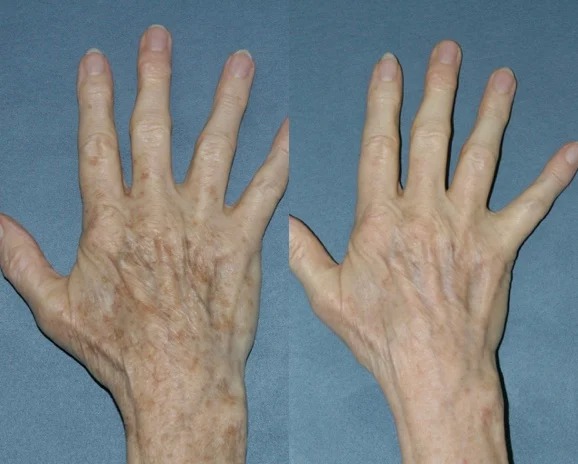Age spots, sometimes referred to as “liver spots” or solar lentigines, are flat gray, brown or black spots found on the skin. They vary in size and usually appear on the face, hands, shoulders, and arms. Age spots are caused by consistent exposure to the sun, and therefore generally occur in adults older than 40, though they can affect younger people as well. Most age spots are harmless and do not require treatment.
Treatment:
If you are unhappy with the appearance of age spots, there are a variety of treatment options aimed at lightening or removing age spots. Because the pigment causing the discolored skin is located at the topmost layer of skin, or the epidermis, treatments intending to lighten age spots must penetrate this layer of skin. Some of the available treatment options include:
- Medications:
Prescription bleaching creams applied over several months may gradually fade age spots. While undergoing this treatment, sun protection is strongly advised. - Laser Therapy:
Laser therapy destroys extra melanocytes that create the dark pigment. This treatment does not damage the skin’s surface and has few side effects. Today’s lasers are able to minimize healing time, and improvement can be seen in just two treatments.
- Freezing (cryotherapy):
During cryotherapy, liquid nitrogen or another freezing agent is applied to the age spots to destroy extra pigment. The skin appears lighter as the area heals. Cryotherapy is generally effective, though it does pose the risk of scarring or permanent skin discoloration. - Dermabrasion:
This procedure involves “sanding down,” or planning the surface layer of your skin with a rotating brush. It removes the skin surface, and a new skin layer grows in its place. Side effects may include scabbing and temporary redness and irritation.
Prevention:
Age spot are very easily prevented by limiting sun exposure, and protecting the skin at all times when exposed. This may include wearing sunscreen at all times, wearing protective clothing such as hats, and remembering to protect skin even when sun damage does not appear to be a risk, such as on a cloudy day, or while driving. It is never too late to begin wearing sunscreen and protecting skin, even if some damage has already occurred.
FAQ about Age Spots:
Though age spots are generally harmless, it is important to never assume a skin lesion is benign. See Dr. Mott if you notice a lesion on your skin, and especially if it changes in color or shape.
Because age spot treatments are considered cosmetic, your insurance may not cover it.
Tanning does contribute to age spots. Tanning is extremely unhealthy, because “a tan” is your body’s way to tell you your skin has been damaged, and is its attempt to protect itself from further damage. Aside from age spots, tanning can lead to a host of problems for your skin, including skin cancer. Dr. Mott recommends you never expose your skin to tanning beds, and always wear sunscreen in direct sun exposure.

